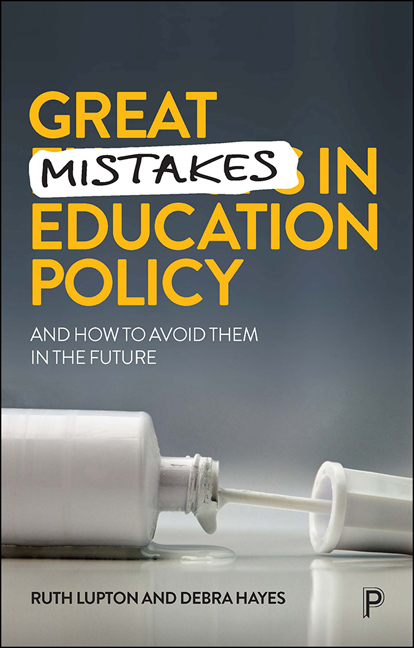Book contents
- Frontmatter
- Contents
- List of tables and boxes
- List of abbreviations
- Notes on the authors
- Acknowledgements
- 1 Introduction
- 2 Setting the scene
- 3 Tests, tests, tests
- 4 Schooling that works for some but not for others
- 5 Teachers making less of a difference
- 6 Mistake #1: turning to the market
- 7 Mistake #2: letting test scores drive policy
- 8 Mistake #3: over-prescribing teachers’ work
- 9 Mistake #4: misunderstanding educational inequalities
- 10 Mistake #5: leaving education out of education policy making
- 11 Synthetic phonics: a ‘perfect storm’ of policy mistakes
- 12 There are alternatives
- References
- Index
4 - Schooling that works for some but not for others
Published online by Cambridge University Press: 23 December 2021
- Frontmatter
- Contents
- List of tables and boxes
- List of abbreviations
- Notes on the authors
- Acknowledgements
- 1 Introduction
- 2 Setting the scene
- 3 Tests, tests, tests
- 4 Schooling that works for some but not for others
- 5 Teachers making less of a difference
- 6 Mistake #1: turning to the market
- 7 Mistake #2: letting test scores drive policy
- 8 Mistake #3: over-prescribing teachers’ work
- 9 Mistake #4: misunderstanding educational inequalities
- 10 Mistake #5: leaving education out of education policy making
- 11 Synthetic phonics: a ‘perfect storm’ of policy mistakes
- 12 There are alternatives
- References
- Index
Summary
One thing about which there seems to be near universal consensus among education policy makers is that education systems should provide equally for all children and provide the opportunity of success for all.
This holds whether you start from the position of the United Nations (UN) goal to ‘Ensure inclusive and equitable quality education and promote lifelong learning opportunities for all’ (United Nations, 2015) or from the UN Convention on the Rights of the Child, Article 29, which states that ‘Education must develop every child's personality, talents and abilities to the full’ (UNICEF, 1992). It holds if you start from goals to reduce inequalities, enhance social mobility and foster social justice, or if you start from economic aspirations to increase human capital, maximise productivity and spend less on welfare. Inclusive and equitable education is, in theory, a ‘no-brainer’.
But it isn't happening. In fact, in far too many cases, children and young people who need the education system most are actually getting less from it than their more advantaged peers. That uncomfortable fact has long been recognised, at least by sociologists of education if not always by politicians. But there is also evidence that the system is increasingly marginalising children who in different ways rely on it most. Instead of compensating for other injustices, the education system may increasingly be making them worse.
Unequal access to schooling
One major factor in the production of educational divisions is the structure of school systems, including differences between and within sectors that make up these systems. This may seem too obvious even to state. Yet it is striking how reluctant policy makers are to recognise these differences. Instead, they put a lot of emphasis and effort into what individual teachers and leaders can do rather than taking action to level up young people's access to schooling resources. So, it is worth restating these long-term features of schooling before moving on to more recent developments.
In England, the ‘elephant in the room’ in discussions of education policy and inequalities is the private school system: small, politically hard-to-touch and incredibly influential in the production of the elite (The Sutton Trust and the Social Mobility Commission, 2019).
- Type
- Chapter
- Information
- Great Mistakes in Education PolicyAnd How to Avoid Them in the Future, pp. 41 - 54Publisher: Bristol University PressPrint publication year: 2021

